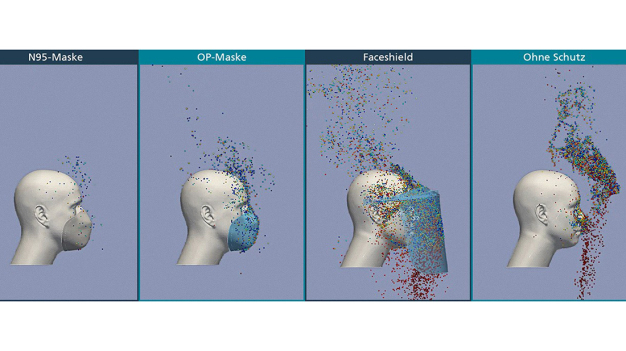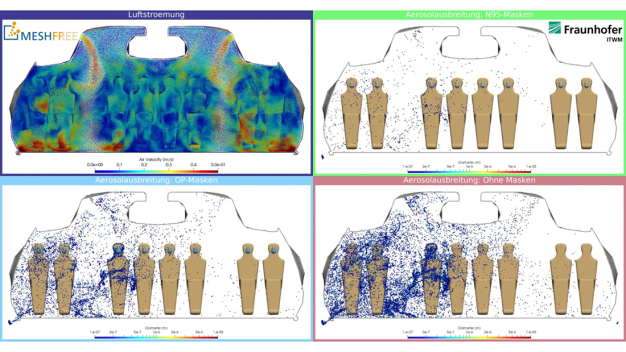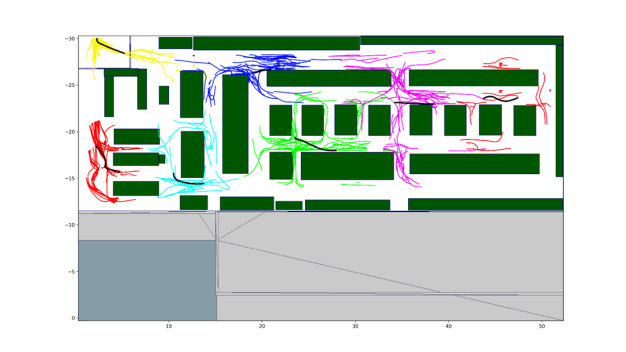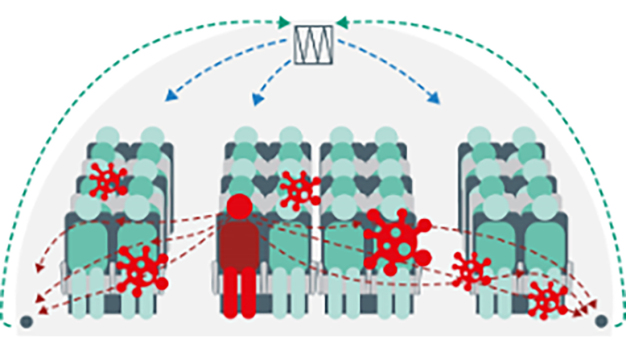- Corona
Tracking down aerosols
How do infectious aerosols spread in supermarkets, airplanes, and other indoor areas where large numbers of people congregate? Researchers from 15 Fraunhofer institutes and institutions are investigating this in the AVATOR project.
Social distancing and wearing a mask are still the order of the day. While the risk of infection is quite low outdoors, infectious aerosols can easily accumulate indoors and lead to infection. How do these aerosols spread, and how high is the risk of infection in airplanes, supermarkets, classrooms and the like?
Simulation chain instead of single simulations
Led by the Fraunhofer Institute for Building Physics IBP, researchers from a total of 15 Fraunhofer institutes and institutions are studying this in the AVATOR project, short for Anti-Virus Aerosol: Testing, Operation, Reduction. “We are simulating and analyzing how viruses spread indoors and searching for ways to purify indoor air effectively,” says Prof. Gunnar Grün, Deputy Director of Fraunhofer IBP and overall manager of the project. What sets this project apart from the rest? Instead of working with a single simulation method, the scientists at the participating institutes are conducting simulations with different techniques and levels of detail over long periods of time. Starting at near field, i. e. very close to the mouth of an infected person, the simulations extend to the far field, such as a large room. How many viruses are released into the room air when different types of masks are worn? How does the airflow behave near a person, and to what extent do any exhaled viruses spread throughout a room over time? “We generate simulations on different scales, which we can combine to form a simulation chain, depending on the task at hand,” Grün explains.
For example, in the near field simulation, Fraunhofer ITWM focuses in particular on how the aerosol concentration in the immediate vicinity of an infected person changes when he or she wears a different mask. The experimental validation data on the flow field were determined by expert teams at Fraunhofer EMI using laser light section and Schlieren measurement techniques. Fraunhofer IBP, on the other hand, is concerned with simulating large areas over longer periods of time, for example in aircraft cabins or production halls. To validate the simulation results, the research teams compare them with measurement data from IBP's own aircraft cabin, which is ideal for studying the airflows occurring inside such areas. “In our simulations at Fraunhofer IBP, we look at the daily routine from start to finish. Our simulations are therefore naturally not nearly as accurate as those of the other institutes, which are limited to simulation times of just a few minutes. However, this is exactly where the great advantage of the simulation chain lies: The simulations complement each other in a meaningful way. Since the transitions between the simulations can be linked, the resulting picture can be extended to gain more information,” says Grün.
Agent simulation takes movements into account
The situation becomes even more complex when people move around in a room rather than just stand still. The Fraunhofer researchers also included this aspect in their simulations by using an agent tool developed by Fraunhofer Singapore. Who walks in which direction? Who does the person come into contact with in the process? Fraunhofer IGD and Fraunhofer EMI, on the other hand, are responsible for simulating the corresponding indoor airflows.
To what extent does turbulence occur as a result of the movement? There is simply not enough computing capacity to simulate all the contacts made. Fraunhofer Austria therefore uses machine learning methods to select representative situations, which are then transferred to the airflow simulation. This targeted use of artificial intelligence is what makes agent-based flow simulation possible in the first place. The consortium has already simulated how aerosols spread in a supermarket with different people moving around. Of course, the model can also be applied to airplanes, classrooms and other rooms.
From the simulations, the researchers can predict how the aerosols spread in specific rooms. For example, how many viruses does a person breathe in on an airplane when an infected person sits one row in front? Two risk models jointly evaluated by Fraunhofer IFF and Fraunhofer ITEM can be implemented to assess the respective risk of infection and the effectiveness of various protective measures. Grün cites one of the results as an example: “By linking the different models, we can see very clearly that wearing an FFP2 mask in an aircraft cabin is sufficient to reduce exposure by more than 95 percent, and thus also the risk of infection.” The exact risk depends, of course, on a number of factors: for example, the precise distance away from the infected person, the quantity of infectious viruses and the duration of stay in the room. From the risk assessment data, the project participants can derive useful hygiene measures and study their effectiveness. Indoor air purification techniques, as well as the evaluation of their effectiveness, are therefore a further focus of developments in the AVATOR project.
Fraunhofer-Institut für Bauphysik IBP
70569 Stuttgart
Germany












